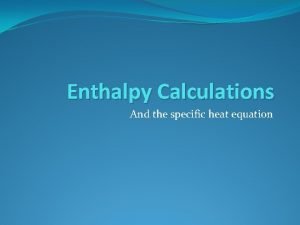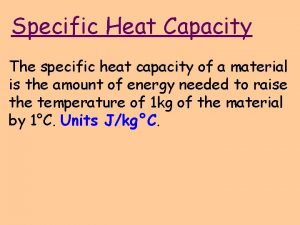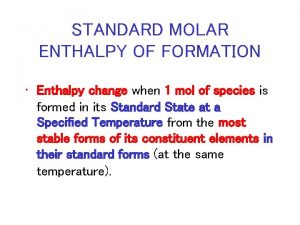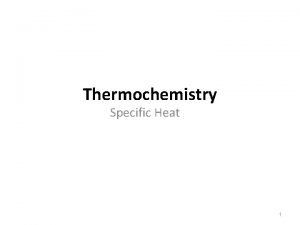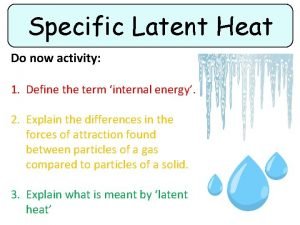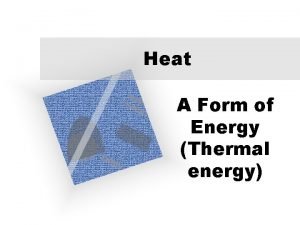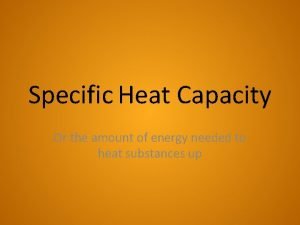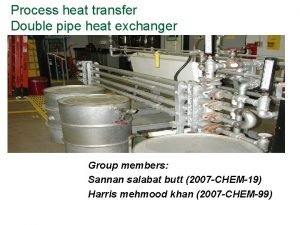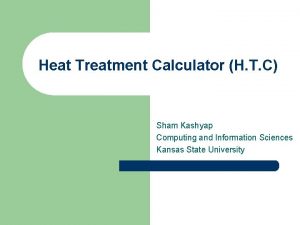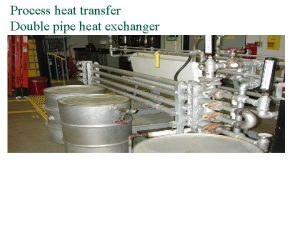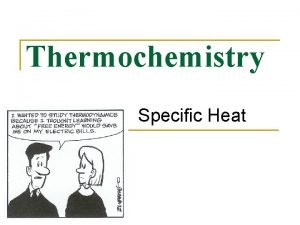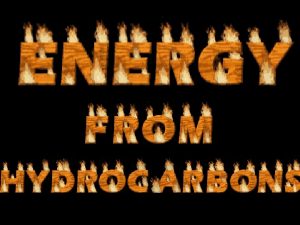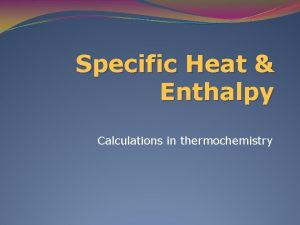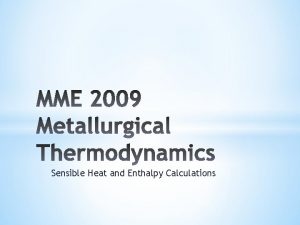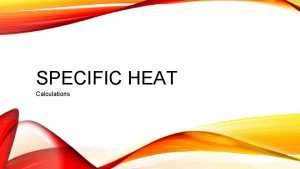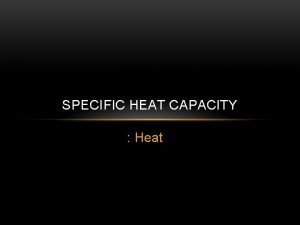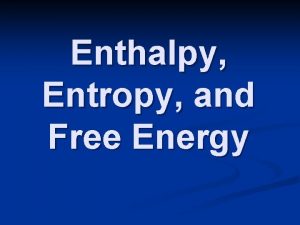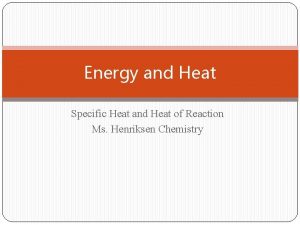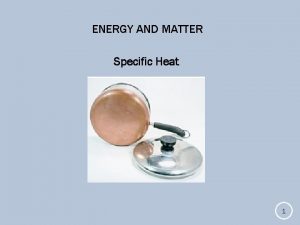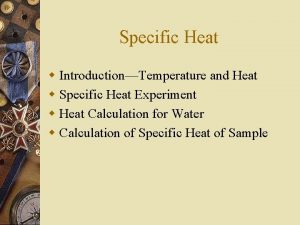Enthalpy Calculations And the specific heat equation Enthalpy


















- Slides: 18

Enthalpy Calculations And the specific heat equation

Enthalpy �The total energy in a system �If the change is positive, endothermic reaction. �If the change is negative, exothermic reaction. �Change in enthalpy is ∆H

Enthalpy calculation �In some cases we are give the values and we simply add them up. �In effect, the energy required to break the bonds added to the energy released when the new bonds are formed. �These are the simple ones!

Specific heat capacity �As we do so many reactions in water, we measure the temperature change of the water. �Do you need as much energy to heat 100 g of water by 5 K as would be needed to heat 100 g of air by the same amount? �Why?

Bonding again �Due to differences in bonding, many substances can absorb more energy than others. �This is called the Specific Heat Capacity. �Water has a higher heat capacity than air and therefore needs more energy to raise its temperature. �The specific heat capacity of water is 4. 18 Jg-1

The equation �The specific heat capacity equation is � DH = -cm. DT �c is the specific heat capacity (4. 18 Jg-1 or 4. 18 Kj. Kg 1) for water. �m is the mass (in g or Kg). �DT is the temperature change (always in K).

CHEMISTRY CALCULATIONS Enthalpy of combustion. The enthalpy of combustion of a substance is the amount of energy given out when one mole of a substance burns in excess oxygen. Worked example 1. 0. 19 g of methanol, CH 3 OH, is burned and the heat energy given out increased the temperature of 100 g of water from 22 o. C to 32 o. C. Calculate the enthalpy of combustion of methanol. Use DH = -cm. DT ( c is specific heat capacity of water, 4. 18 k. J kg-1 o. C-1) m is mass of water in kg, 0. 1 kg DH = -4. 18 x 0. 1 x 10 DT is change in temperature in o. C, 10 o) DH = - 4. 18 k. J Use proportion to calculate the amount of heat given out when 1 mole, 32 g, of methanol burns. 0. 19 g So 32 g -4. 18 k. J 32/ 0. 19 x – 4. 18 = -704 k. J Enthalpy of combustion of methanol is – 704 k. J mol-1.

Calculation using enthalpy of combustion Calculations for you to try. 1. 0. 25 g of ethanol, C 2 H 5 OH, was burned and the heat given out raised the temperature of 500 cm 3 of water from 20. 1 o. C to 23. 4 o. C. Use DH = -cm. DT DH = -4. 18 x 0. 5 x 3. 3 = - 6. 897 k. J Use proportion to calculate the enthalpy change when 1 mole, 46 g, of ethanol burns. 0. 25 g So 46 g -6. 897 k. J 46/ 0. 25 x -6. 897 = -1269 k. J mol-1. 2. 0. 1 moles of methane was burned and the energy given out raised the temperature of 200 cm 3 of water from 18 o. C to 28. 6 o. C. Calculate the enthalpy of combustion of methane. Use DH = -cm. DT DH = -4. 18 x 0. 2 x 10. 6 = - 8. 86 k. J Use proportion to calculate the enthalpy change when 1 mole of methane burns. 0. 1 mol So 1 mol -8. 86 k. J 1/ 0. . 1 x -8. 86 = -88. 6 k. J mol-1.

Calculation using enthalpy of combustion Worked example 2. 0. 22 g of propane was used to heat 200 cm 3 of water at 20 o. C. Use the enthalpy of combustion of propane in the data book to calculate the final temperature of the water. Burning 1 mole, 44 g, of propane DH = -2220 k. J By proportion burning 0. 22 g of propane DH = 0. 22/ x – 2220 44 = - 11. 1 k. J Rearrange DH = -cm. DT to give DT = DH -cm -11. 1 DT = -4. 18 x 0. 2 = 13. 3 o. C Final water temperature = 20 + 13. 3 = 33. 3 o. C

Calculation using enthalpy of combustion Calculations for you to try. 1. 0. 1 g of methanol, CH 3 OH, was burned and the heat given out used to raise the temperature of 100 cm 3 of water at 21 o. C. Use the enthalpy of combustion of methanol in the data booklet to calculate the final temperature of the water. Burning 1 mole, 32 g, of methanol DH = -727 k. J By proportion burning 0. 1 g of methanol DH = 0. . 1/ 32 x – 727 = - 2. 27 k. J Rearrange DH = -cm. DT to give DT = DH -cm -2. 27 DT = -4. 18 x 0. 1 = 5. 4 o. C Final water temperature = 21 + 5. 4 = 26. 4 o. C

Calculation using enthalpy of combustion Calculations for you to try. 2. 0. 2 g of methane, CH 4, was burned and the heat given out used to raise the temperature of 250 cm 3 of water Use the enthalpy of combustion of methane in the data booklet to calculate the temperature rise of the water. Burning 1 mole, 16 g, of methane DH = -891 k. J By proportion burning 0. 2 g of methane. DH = 0. . 2/ 16 x – 891 = - 11. 14 k. J Rearrange DH = -cm. DT to give DT = DH -cm -11. 14 DT = -4. 18 x 0. 25 = 10. 66 o. C

CHEMISTRY CALCULATIONS Enthalpy of Solution. The enthalpy of solution of a substance is the energy change when one mole of a substance dissolves in water. Worked example 1. 5 g of ammonium chloride, NH 4 Cl, is completely dissolved in 100 cm 3 of water. The water temperature falls from 21 o. C to 17. 7 o. C. Use DH = -cm. DT ( c is specific heat capacity of water, 4. 18 k. J kg-1 o. C-1) m is mass of water in kg, 0. 1 kg DH = -4. 18 x 0. 1 x -3. 3 DT is change in temperature in o. C, -3. 3 o. C) DH = 1. 38 k. J Use proportion to find the enthalpy change for 1 mole of ammonium chloride, 53. 5 g, dissolving. So 5 g 53. 5 g 53. 5/ 1. 38 k. J 5 x 1. 38 = 17. 77 k. J mol-1. Note: - As the temperature falls the reaction is endothermic (takes in heat) – this is shown by the positive value for the enthalpy change.

Calculations for you to try. 1. 8 g of ammonium nitrate, NH 4 NO 3, is dissolved in 200 cm 3 of water. The temperature of the water falls from 20 o. C to 17. 1 o. C. Use DH = -cm. DT DH = -4. 18 x 0. 2 x -2. 9 DH = 2. 42 k. J Use proportion to find the enthalpy change for 1 mole, 80 g, of ammonium nitrate dissolving. 8 g So 80 g 2. 2. 42 k. J 80/ 8 x 2. 42 = 24. 2 k. J mol-1. When 0. 1 mol of a compound dissolves in 100 cm 3 of water the temperature of the water rises from 19 o. C to 22. 4 o. C. Calculate the enthalpy of solution of the compound. Use DH = -cm. DT DH = -4. 18 x 0. 1 x 3. 4 DH = -1. 42 k. J Use proportion to find the enthalpy change for 1 mole of the compound. So 0. 1 mol - 1. 42 k. J 1 mol 1/ 0. 1 x -1. 42 = -14. 2 k. J mol-1.

Calculations for you to try. 3. The enthalpy of solution of potassium chloride, KCl, is + 16. 75 k. J mol -1. What will be the temperature change when 14. 9 g of potassium chloride is dissolved in 150 cm 3 of water? Use proportion to find the enthalpy change for 14. 9 g of potassium chloride dissolving. 74. 6 g (1 mol) So 14. 9 g 16. 75 k. J 14. 9/ 74. 6 x 16. 75 = 3. 35 k. J Rearranging DH = -cm. DT Gives DT = DH DT = -cm 3. 35 -4. 18 x 0. 15 = -5. 34 o. C

CHEMISTRY CALCULATIONS Enthalpy of neutralisation. The enthalpy of neutralisation of a substance is the amount of energy given out when one mole of a water if formed in a neutralisation reaction. Worked example 1. 100 cm 3 of 1 mol l-1 hydrochloric acid, HCl, was mixed with 100 cm 3 of 1 mol -1 sodium hydroxide, Na. OH, and the temperature rose by 6. 2 o. C. Use DH = -cm. DT ( c is specific heat capacity of water, 4. 18 k. J kg-1 o. C-1) m is mass of mixed solution in kg, 0. 2 kg DH = -4. 18 x 0. 2 x 6. 2 DT is change in temperature in o. C, 6. 2 o. C) DH = - 5. 18 k. J The equation for the reaction is HCl + Na. OH Na. Cl + H 2 O Number of moles of acid used = Number of moles of alkali = C x V (in litres) = 1 x 0. 1 = 0. 1 So number of moles of water formed = 0. 1 Use proportion to find the amount of heat given out when 1 mole of water is formed. So 0. 1 mole -5. 18 k. J 1 mole 1/ 0. 1 x – 5. 18 = -51. 8 k. J mol-1.

Calculation using enthalpy of neutralisation. Calculations for you to try. 1. 400 cm 3 of 0. 5 mol l-1 hydrochloric acid. HCl, was reacted with 400 cm 3 of 0. 5 mol l -1 potassium hydroxide and the temperature rose by 3. 2 o. C Calculate the enthalpy of neutralisation. Use DH = -cm. DT DH = -4. 18 x 0. 8 x 3. 2 DH = - 10. 70 k. J The equation for the reaction is HCl + KOH KCl + H 2 O Number of moles of acid used = Number of moles of alkali = C x V (in litres) = 0. 5 x 0. 4 = 0. 2 So number of moles of water formed = 0. 2 Use proportion to find the amount of heat given out when 1 mole of water is formed. So 0. 2 mole -10. 70 k. J 1 mole 1/ 0. 2 x -10. 70 = -53. 5 k. J mol-1.

Calculation using enthalpy of neutralisation. Calculations for you to try. 2. 250 cm 3 of 0. 5 mol l-1 sulphuric acid. H 2 SO 4, was reacted with 500 cm 3 of 0. 5 mol l -1 potassium hydroxide and the temperature rose by 2. 1 o. C Calculate the enthalpy of neutralisation. Use DH = -cm. DT DH = -4. 18 x 0. 75 x 2. 1 DH = - 6. 58 k. J The equation for the reaction is H 2 SO 4 + 2 Na. OH Na 2 SO 4 + 2 H 2 O 1 mole of acid reacts with 2 moles of alkali to form 1 mole of water. Number of moles of acid used = 0. 5 x 0. 25 = 0. 125 Number of moles of alkali used = 0. 5 x 0. 5 = 0. 25 So number of moles of water formed = 0. 125 Use proportion to find the amount of heat given out when 1 mole of water is formed. So 0. 125 mole -6. 58 k. J 1 mole 1/ 0. 125 x -6. 58 = -52. 64 k. J mol-1.

Calculation using enthalpy of neutralisation Calculations for you to try. 3. 100 cm 3 of 0. 5 mol l-1 Na. OH is neutralised by 100 cm 3 of 0. 5 mol l-1 HCl. Given that the enthalpy of neutralisation is 57. 3 k. J mol-2, calculate the temperature rise. The equation for the reaction is HCl + Na. OH Na. Cl + H 2 O 1 mole of acid reacts with 1 mole of alkali to form 1 mole of water. Number of moles of acid used = 0. 5 x 0. 1 = 0. 05 Number of moles of alkali used = 0. 5 x 0. 1 = 0. 05 So number of moles of water formed = 0. 05 Use proportion to find the amount of energy given out when 0. 05 moles of water is formed. 1 mol So 0. 05 mol DT = -57. 3 k. J DH -cm = 0. 05/ 1 x -57. 3 -2. 865 -4. 18 x 0. 2 = -2. 865 k. J = 3. 4 o. C
 Enthalpy of water equation
Enthalpy of water equation Specific heat of water
Specific heat of water Latent heat problems
Latent heat problems Types of connections in steel structures
Types of connections in steel structures Properties of heat
Properties of heat How to calculate enthalpy change
How to calculate enthalpy change Hess law for combustion
Hess law for combustion Calculation of enthalpy
Calculation of enthalpy Specific heat equation units
Specific heat equation units Latent heat definition physics
Latent heat definition physics What is latent heat capacity
What is latent heat capacity Thermal energy equation
Thermal energy equation Measure thermal energy
Measure thermal energy Heat capacity of rubber
Heat capacity of rubber Single pipe heat exchanger
Single pipe heat exchanger Htc calculator
Htc calculator Single pipe heat exchanger
Single pipe heat exchanger How to solve specific heat
How to solve specific heat Final temperature formula
Final temperature formula
